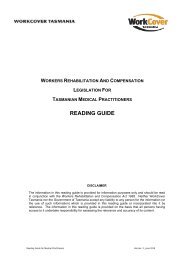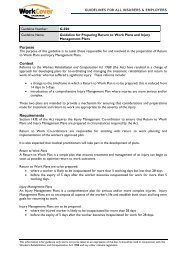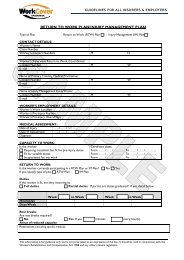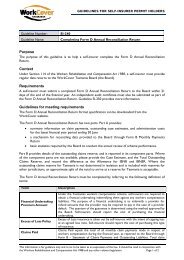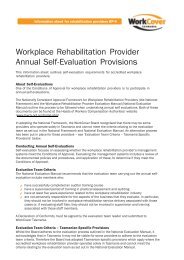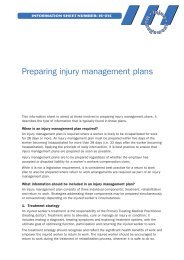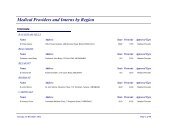Guidelines for the assessment of permanent impairment Version 3
Guidelines for the assessment of permanent impairment Version 3
Guidelines for the assessment of permanent impairment Version 3
Create successful ePaper yourself
Turn your PDF publications into a flip-book with our unique Google optimized e-Paper software.
Chapter 2Upper Extremity ImpairmentIntroduction2.1 The hand and upper extremity is discussed in section 3.1 <strong>of</strong> Chapter 3 in <strong>the</strong> AMA 4 Guides (pp15 - 74). This long section provides guidelines on methods <strong>of</strong> assessing <strong>permanent</strong> <strong>impairment</strong>involving <strong>the</strong>se structures. It is a complex section that requires an organised approach with carefuldocumentation <strong>of</strong> findings on a worksheet.The Approach to Assessment <strong>of</strong> <strong>the</strong> Upper Extremity and Hand2.2 Assessment <strong>of</strong> <strong>the</strong> upper extremity mainly involves clinical evaluation. Cosmetic and functionalevaluations are per<strong>for</strong>med in some situations. The <strong>impairment</strong> must be <strong>permanent</strong> and stable. Theworker will have a defined diagnosis that can be confirmed by examination.2.3 The assessed <strong>impairment</strong> <strong>of</strong> a part or region can never exceed <strong>the</strong> <strong>impairment</strong> due to amputation <strong>of</strong>that part or region. For an upper limb, <strong>the</strong>re<strong>for</strong>e, <strong>the</strong> maximum <strong>assessment</strong> is 60% WPI.2.4 To achieve an accurate and comprehensive <strong>assessment</strong> <strong>of</strong> <strong>the</strong> upper extremity, findings should bedocumented on a standard <strong>for</strong>m. Figure 1 <strong>of</strong> <strong>the</strong> AMA 4 Guides (pp 16 - 17) is extremely useful,both to document findings and to guide <strong>assessment</strong>.Note, however, that <strong>the</strong> final summary part <strong>of</strong> Figure 1 (pp 16 - 17, AMA 4 Guides) does notmake it clear that <strong>impairment</strong>s due to peripheral nerve injuries cannot be combined with o<strong>the</strong>r<strong>impairment</strong>s in <strong>the</strong> upper extremities unless <strong>the</strong>y are separate injuries. This is to avoid“double-dipping”.2.5 The hand and upper extremity are divided into regions that are <strong>the</strong> thumb, fingers, wrist, elbow,and shoulder. Close attention needs to be paid to <strong>the</strong> instructions in Figure 1 (pp 16 - 17, AMA 4Guides) regarding adding or combining <strong>impairment</strong>s.2.6 Table 3 (p 20, AMA 4 Guides) is used to convert upper extremity <strong>impairment</strong> to whole person<strong>impairment</strong>. Note that 100% upper extremity <strong>impairment</strong> is equivalent to 60% WPI.2.7 If <strong>the</strong> condition is not in <strong>the</strong> AMA 4 Guides, it may be assessed using ano<strong>the</strong>r like condition.WCT <strong>Guidelines</strong> 1 October 2011 9



